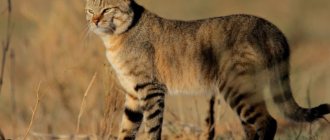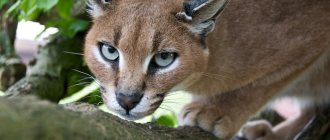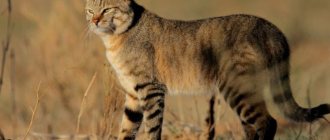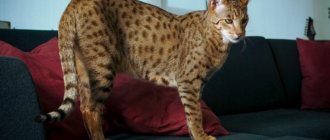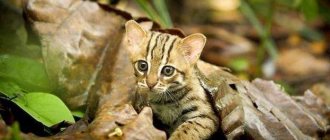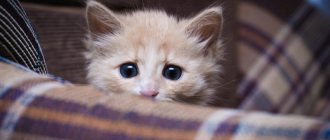The steppe cat is a “wild cat” that looks like a domestic cat, but is larger in size and has a different body color. It lives in Africa, Asia and the islands of the Mediterranean Sea. These predators are also called African wild cats.
Steppe cats live in sandy deserts overgrown with black saxaul, on clayey plains with lakes and are found in the foothills near bodies of water. Steppe cats are often found close to human settlements. They settle in places where there is free access to water and food.
Description of the steppe cat
Body length ranges from 63 to 70 centimeters, tail length is 23-33 centimeters, shoulder height is up to 35 centimeters, and weight ranges from 3 to 8 kilograms. Females are larger and heavier compared to males.
The claws of these predators are completely retractable. The tail is long. The ears are large. The jaws are strong with large incisors. The total number of teeth in the mouth is 30.
In winter, the main color of the steppe cat is grayish-yellow or sandy, and there are black spots on the sides of the body and on the back. The tail has several black rings. The throat and underbelly are white.
Nutrition and behavior
Steppe cats are loners, preferring an isolated lifestyle. Each male is assigned a certain territory, intersecting with the possessions of several females.
Cats are nocturnal, and during the day they hide in bushes or burrows. Their paws are not adapted for digging, so burrows abandoned by foxes, porcupines or badgers act as homes. During the cold season, steppe cats sit out in a hole insulated with feathers, dried grass and the skins of killed rodents.
Wild cats prefer:
- small rodents;
- reptiles;
- insects;
- birds;
- amphibians.
Animals attack prey in a jump from a distance of 1 meter or stalk for a long time near the shelter. Sharp claws allow them to deftly climb trees, a tongue with hard scales easily frees meat from the bones of prey, and sharp teeth act as the main weapon during the hunt.
Natural enemies of steppe cats include dogs and wolves. Martens are dangerous for kittens and young animals. When confronted with an enemy, the cat arches its back, sticks out its tail and raises its fur, trying to intimidate the enemy with its size. If the “trick” fails, then fall on the back and attack with all paws armed with sharp claws.
Lifestyle of steppe cats
Outside the breeding season, African wild cats lead a solitary lifestyle. These are terrestrial nocturnal predators. Although prairie cats are excellent tree climbers, they prefer to spend most of their time on the ground.
Steppe cats begin to hunt at dusk or at night.
In cold weather, they can also be found during the daytime. They rest in rock crevices, thick grass, abandoned burrows or ravines. Steppe cats make the same sounds as domestic cats.
The diet of African cats consists of small animals: house mice, gerbils, ground squirrels, hares, muskrats, jerboas, sparrows, pheasants, and domestic chickens. They also eat insects and lizards.
Steppe cat (Felis silvestris lybica).
The main natural enemies of steppe cats are wild dogs. Their lifespan is 12-15 years.
History of the species and the process of human domestication
Moreover, the cat often catches mice everywhere, and not in a place strictly specified by the owner. However, this proximity suited both sides, so now we have many practical and aesthetic cat breeds, united by one genetic ancestor.
Now wild steppe cats prefer not to establish contact with humans. They can be seen near houses only in winter, when rodents move from the fields to barns, around which wild cats hunt.
INTERESTING: until 2021, the species had 15 subspecies, but now such a broad classification is no longer valid. All steppe cats are divided into only three subspecies: Asian, South African and African steppe cats. They are all essentially the same species, but have a number of external differences due to their habitat.
All steppe cats, regardless of subspecies, are listed in the Red Book with a rating of 4 - a small population with unknown dynamics. This is due to the survival of cats from wild places by civilization and crossing with domestic cats, which erodes the purity of the population of both sides.
Reproduction of African wild cats
The breeding season for steppe cats is from January to March. At this time, one female is pursued by 2-3 males. The female gives birth in an abandoned den of a badger, fox, gopher or porcupine. Before occupying the den, the female expands it.
Pregnancy lasts 56-63 days, after which 3-5 blind and completely helpless kittens are born.
The steppe cat lives in steppe, desert and sometimes mountainous regions of Africa.
After a few days, the babies begin to crawl. On the 10th day their eyes open, and on the 20th day they begin to run. Kittens do not leave the den until they are one month old, after which they begin to explore the world around them. The mother feeds the babies with milk until they are one month old. When the kittens grow up, they begin to go hunting with the female. They become completely independent at 5-6 months. Puberty in steppe cats occurs at 11 months.
Details
External description
Considering the difference between all three subspecies of the steppe cat, it is difficult to combine the external description into a single system, although common features are still present in all three.
- African Prairie Cat: The coat matches the color of its surroundings and ranges from sandy to grey-yellow. The hair is short, soft, with little undercoat and a close fit. All colors have stripes of darker shades. On the paws and tail the stripes are almost black and clear, but on the body the stripes are a couple of shades darker than the main color of the coat, with torn edges and blurred boundaries. Weight varies from 3.5 to 6.5 kilograms, and the length of the body and tail varies from 45-75 and 20-38 centimeters, respectively. The legs are very long, equal in proportion to the width of the two bodies. It looks a little comical, as if a cat had long ago missed a giraffe on its evolutionary path. The rest of the body is proportional, like that of any mongrel cat.
- Asian Steppe Cat: Slightly larger than its African cousin, an adult cat can grow up to 7 kilograms and 79 centimeters in length. The color often contains gray and brown, but sandy shades are still preserved. The most important difference in color is that the subspecies is spotted, not striped. At the same time, the tail most often has closed stripes, on the paws there are elongated horizontal spots, and the body is exclusively with dark polka dots. The undercoat of the Asian subspecies is even smaller than that of the African, and the short hair does not adhere to the body. A shaggy cat is more similar in body structure to an ordinary cat - the paws are harmonious with the size of the body and there is no “resemblance to a giraffe”.
- South African steppe cat: the smallest of the species, although the difference is only half a kilo - an adult cat grows up to 70 centimeters and 6 kilograms in weight. The color of the fur coat is not bright, gray is always mixed with iron-red or ocher tones. The pattern on the body is expressed on the elbows and the edge of the tail; on the rest of the surface, spots or stripes are faintly visible and serve more as a camouflage function than as a deterrent. The coat hair is soft, with the most abundant undercoat within the species. The legs are slightly longer than those of the Asian steppe cat, but the harmony of proportions is not broken.
The gamma of the iris remains the same for all three subspecies. It is either yellow, green, or amber, which is, in principle, characteristic of small wild cats.
Behavior in the wild
Regardless of the territory, steppe cats prefer to settle in steppes, semi-deserts and deserts; only in Africa can the species climb into mountainous areas. In Astrakhan, Orenburg and Saratov, the species prefers to stay in the floodplains of rivers, building its nest in the bushes. In general, both the steppe cat of the Saratov region and the steppe cat of South Africa are all cats that mimic the environment, hunt at dusk and prefer to occupy holes and shelters after foxes, badgers, fennecs and hares. Sometimes a hollow can become a place for daytime rest, but due to the characteristics of the territory it occupies, this type of shelter is not very common among the species.
The only thing that neither subspecies likes is snow and frost. Not a single subspecies of wild steppe cat has sufficient undercoat to endure a thick layer of snow and wind with frost like a Siberian.
The habitats and hunting style of the species depend on gender. Females are content with a small territory, preferring to occupy it once and for all. Males roam across several habitats of females, sometimes winning a new potential mate from the male of a neighboring area.
The species goes hunting only at night. This, firstly, is typical for all small cats, and secondly, in the steppe there is almost no place to hide, and the species is a master of close-range hunting, which puts itself at risk from larger predators. The species also prefers not to meet with its fellows when hunting. If a male hunts in the territory of a particular female, then they will keep a distance from each other. Cats meet and have contact with cats only during the race to conceive offspring.
INTERESTING: wherever the steppe cat lives, he improves his home. A rock crevice, hollow or abandoned hole will always be lined with dry grass or feathers of prey, and the toilet will always be moved outside the territory. If fleas or other parasites appear in a cat’s house, the cat leaves its habitual home and looks for a new “non-infectious” home.
The species prefers to escape from enemies into holes, and it doesn’t matter whether it’s their own or not - any hole will do in a moment of danger. A wild cat rarely climbs a tree, since it rarely comes into contact with such a surface and often climbs poorly. If there is nowhere to hide, and the technique with a hiss and an arched back does not work, then the cat lies on its back and stretches its paws up with its claws extended, causing the maximum possible harm to the predator. In general, these are the habits of an ordinary domestic cat, for example, encountering a strange dog.
The list of enemies in the wild for the steppe cat again depends on its place of residence and the proximity of human settlement. The species is not considered as a fur animal, so it suffers from wolves, dogs, and lynxes. Kittens also become victims of predatory nocturnal birds, which catch playing babies near their holes while the female is hunting.
The cat itself hunts:
- Mice are the mainstay of the species' diet.
- Lizards.
- Invertebrates in water.
- Birds - very rarely and only not terrestrial, often destroying the nest, but not eating the mother herself.
- Insects - if you are really hungry.
- Turtles are very rare, only if they are present in the reservoirs of the range.
The species does not track prey, preferring to ambush in several jumps. The larger the game, the faster the attack from the back; the steppe cat aims directly at the artery, without getting into a fight with the food.
The species ruts twice a year in December-February and May-July. The male and female spend several days together, after which pregnancy occurs for 60-68 days, depending on multiple births. After mating, the male does not always leave the female; sometimes long-term monogamous pairs are formed, raising more than one generation of kittens.
A cat gives birth to very tiny kittens, sometimes babies weigh up to 65 grams. Only those who carried 90 grams or more in the womb survive.
INTERESTING: in all subspecies, kittens are born blue-eyed and with pink pads on their paws. By three months, the iris acquires an adult color, and the paws darken.
Steppe cat kittens grow up rapidly. At 2 months, babies are ready to hunt together with their mother. At 4-5 months, the litter still lives with the female, but already hunts in the mother’s territory on its own. At 6 months, kittens leave their parents. In a year, both sexes are ready to reproduce and already have their own permanent territory.
In the wild, the species lives up to 14 years; in homes and zoos, some individuals live up to 21 years. However, the species is suitable for reproduction only up to 8 years of age.
INTERESTING: two female steppe cats live in the Moscow Zoo. The ladies have already passed childbearing age, but still show dexterity and grace. During the day, cats live in an enclosure, and at night they are given access to the inner enclosure of the zoo. At demonstration feedings, cats are particularly delighted with quails and live mice, although females eat chicken and beef in fillet format with no less pleasure.
Modern domestication
Despite the fact that the species was successfully domesticated and gave its genes to many native and later purebred cats of the world, the wild steppe cat does not feel tenderness towards humans. You can tame a cat, but you need to do this when the kitten is only 2-3 weeks old and does not have any skills from the mother cat about the world outside the hole. A wild cat kitten can be placed with a domestic cat that has given birth and raised by her with all the rules of socialization and accustomed to human hands.
Growing up, the steppe cat will be a good guard of the house from rodent attacks, but it will never become affectionate and tame. Wild instincts will still take over, and the cat will rather consider you and the house as its habitat rather than perceive you as a full-fledged owner. Yes, he won’t refuse food, and in moments of overabundance of feelings he can rub himself against his legs, but he will show all his feline independence to the fullest.
IMPORTANT: the wild steppe cat, due to its status as an endangered species, is prohibited from being kept in private houses and apartments. You cannot legally buy a kitten. On the black market, there is a high risk of encountering a fake in the form of wild kittens of an ordinary cat that lambed far from humans.
Secretive and lonely cat
Photo: www.cmzoo.org
The steppe cat is a poor sprinter. When hunting, he moves slowly but purposefully. Its activity in search of food is highest at dusk and dawn. Pallas's cat is a skilled predator. It stalks its prey, using rocky terrain and short vegetation for cover, or sometimes waits at the entrance to a burrow and pounces when its occupants emerge.
For small cats, they have fairly large territories with very low population densities. The average habitat of male Pallas' cat is 98 square meters. km, it overlaps the ranges of several females. The average home range for females is 23 square meters. km.
Did you know?
- Despite their small size, Pallas' cats are incredibly aggressive. Kittens will growl before they can even open their eyes.
- Pallas's cats make a variety of sounds. When excited, they squeal or growl, making a sound similar to a small dog whining. Pallas cats can also purr.
- They have unusual pupils. Unlike other members of the cat family, the pupils of the Pallas' cat narrow to small circles instead of vertical slits.
- The average lifespan of a steppe cat is approximately 10-12 years.
The population is declining
Despite their widespread distribution, the number of Pallas' cats is very small. According to the IUCN Red List, the total population of Pallas's cats is 15,315 adults. Today, the species' population is declining and it is classified as critically endangered.
Photo: www.japari-library.com
Habitat loss due to overgrazing and government-sponsored pika control programs threatens pika populations. The prairie cat is also hunted for its luxurious fur and fat, the latter of which is used in some Eastern medicines to treat frostbite.
Habitat
Despite its name, the steppe cat does not particularly favor open areas; it settles in semi-desert and steppe zones with an abundance of thickets and shrubs. Mountainous areas are also suitable for this animal, but the cat does not climb above 3000 meters above sea level. The animal's habitat is wide; it can be found in mountainous African regions, India, Central and Northern Asia and Transcaucasia. The animal is rare on the territory of Russia; its traces, and if you are lucky, the animal itself, can be seen in the semi-deserts of the Astrakhan region. The spotted cat lives closer to water bodies, in thickets of plants, avoiding open areas and places where there is a lot of rainfall.
The steppe cat prefers areas with an abundance of thickets and bushes
These cats were named after Peter Pallas
Peter Pallas, an eighteenth-century German zoologist, first classified the Pallas cat as "Felis manul" in 1776. The word "manul" has Turkic roots. Its current scientific name "Otocolobus" is Greek for "ugly". When Pallas first described the Pallas cat, he mistakenly assumed that it was the ancestor of the Persian domestic cat due to its long coat, dense build, and flat face.
Photo: Julie Larsen Maher
Fur for acclimatization and camouflage
The Pallas's cat has the longest and thickest fur of all cats. Its fur is almost twice as long on its belly and tail as on the top of its head and sides. The length and thickness of the fur also varies depending on the season, becoming longer and heavier in winter to protect the animal from the snow when chasing prey. The fur helps Pallas' cats stay warm when winter temperatures drop to -50°C. In summer they can tolerate temperatures of around 38°C, seeking refuge in burrows or crevices.
The steppe cat changes color twice. In winter its coat is grayer and more uniform in color, while in summer it has buffy fur with more stripes. Since the environment around the Pallas's cat does not have many shelters, this change of colors helps it blend into the landscape.
A characteristic feature of Pallas cats is the nictitating membrane above the eye or third eyelid. It helps them protect themselves from the cold and often dusty winds of the environment. And their small, tightly set ears help them hide.
